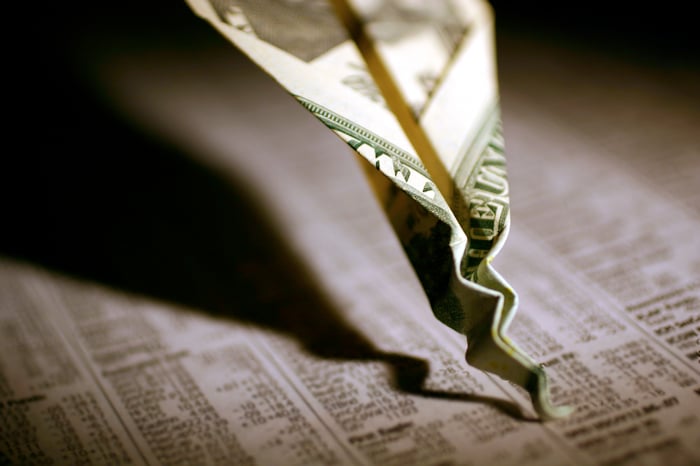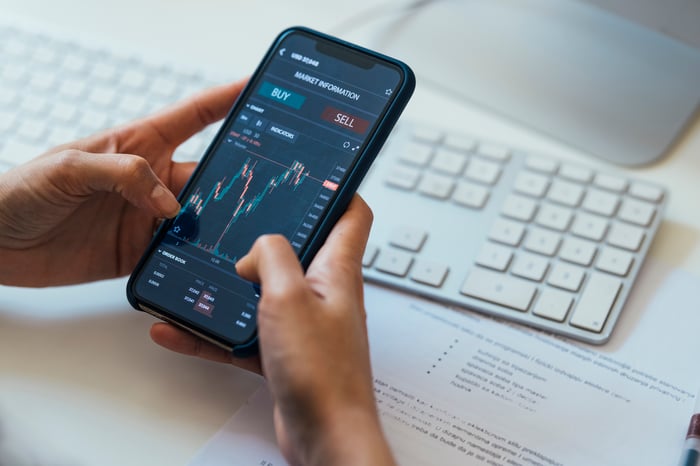For the past year and a half, investors have been privy to the greatest bounce back from a bear-market bottom in history. It took less than 17 months for the benchmark S&P 500 (^GSPC -0.22%) to double after shedding a third of its value in a month during the initial wave of the coronavirus pandemic.
But this perfect march higher may be encountering trouble.
This past Monday, Sept. 20, the S&P 500 suffered its worst single-session loss since May. Could this mark a turning of the tide for the broader market or even a stock market crash? Here's what the data suggests could happen, as well as what you should do in response to these concerns.

Image source: Getty Images.
The case for double-digit downside in the stock market is building
Before I dive into the data, let's get one very important tidbit of information out of the way. It's absolutely impossible to predict with any preciseness when a stock market crash or correction will occur, how steep it'll be, or how long it'll last. With this being said, there are a growing number of warning signs that double-digit percentage downside is brewing.
To begin with, the S&P 500 has an uncanny track record of falling significantly when valuations get really extended, as they are now. Over the last 151 years, the S&P 500's Shiller price-to-earnings (P/E) ratio has surpassed and held past 30 on five separate occasions, including now (Shiller P/E of 36.7, as of Sept. 21). The Shiller P/E examines inflation-adjusted earnings over the past 10 years. In the previous four instances where the Shiller P/E topped 30, the index subsequently fell by a minimum of 20%.
Margin debt is another clear worry. Margin debt describes the amount of money borrowed by investors with interest to buy or short-sell securities. While it's not abnormal to see nominal margin debt outstanding rise over time, it is unusual for margin debt outstanding to climb 60% or more in a single year. Over the past quarter of a century it's only happened three times: Directly before the dot-com bubble burst, directly before the Great Recession, and in 2021. A cascade of margin calls could be very bad news for the broader market.
History isn't the market's friend, either, at least in the very short term. When we look back at how the S&P 500 responded following each of its previous eight bear markets, dating back to 1960, we see that it underwent one or two declines of at least 10% within the first 36 months following a bear-market bottom. In other words, bouncing back from a recession or fear-induced event is a process that has bumps in the road. After 18 months, we've not had any bumps in the road.

Image source: Getty Images.
History is actually one of investors' greatest allies
Even though history would seem to suggest that the S&P 500 could find itself in some trouble here sooner than later, history is also one of investors' best friends.
Since 1950, the benchmark S&P 500 has undergone 38 double-digit declines. Each and every one of these declines was eventually put in the rearview mirror by a bull market rally. Put another way, every single crash or correction throughout history has been a buying opportunity, as long as your investment timeline is measured in years and not days, weeks, or months.
Something else to notice about double-digit declines in the S&P 500 is that most don't last very long. The average amount of time it's taken the S&P 500 to go from peak to bottom in the 38 crashes and corrections since 1950 is 188 days. That's about six months. Meanwhile, the market has spent a considerably longer amount of time in bull-market mode.
Want further proof that time and history are on investors' side? Earlier this year, Crestmont Research released a report showing that the S&P 500's 20-year rolling total returns (including dividend payouts) have never been negative between 1919 and 2020. This means if you looked at all 102 end years between 1919 and 2020, the average annual rolling 20-year total return would have been positive.
History is pretty clear when it comes to crashes and corrections: Long-term investors should be buying, not running for the hills.

Image source: Getty Images.
Three perfect examples of stocks to buy if a crash occurs
With the long-term data unquestionably favoring optimists, here are a trio of stocks to consider buying if Monday's bigger-than-normal pullback does turn into a full-fledged correction or even crash.
For growth stock investors, social media kingpin Facebook (META 1.54%) is an incredibly solid add during double-digit market declines. Facebook ended June with a hair north of 3.5 billion monthly active users. That's about 44% of the global population visiting an owned asset monthly. Advertisers are fully aware that there's no other platform on the planet that'll offer them more eyeballs for their message than Facebook, which is what gives the company such impressive ad-pricing power.
What's more, Facebook isn't even close to monetizing all of its assets yet. Though it's generating ad revenue from Instagram and its namesake site, Facebook Messenger and WhatsApp, which are two of the most-visited platforms in the world, haven't been meaningfully monetized.
Don't overlook Facebook's Oculus devices, either. Facebook is angling to be the leader in virtual reality, which should be one of the fastest-growing trends of the decade.

Image source: CVS Health.
CVS Health
Value stock investors should consider buying pharmacy chain CVS Health (CVS 1.15%) on any big dip in the broader market. Since people don't get to choose when they get sick or what ailment(s) they develop, there tends to be pretty steady demand for prescription services no matter how well or poorly the stock market is performing.
What separates CVS from much of its competition is the company's vertical expansion. Rather than buying more pharmacies, CVS acquired health insurer Aetna in late 2018. Aetna's health insurance operations are a boost to CVS's organic growth rate, and it gives Aetna's more than 20 million members reason to stay within CVS Health's pharmacy ecosystem.
CVS is also appealing to customers at the grassroots level by opening up to 1,500 HealthHUB health clinics in the U.S. These clinics aim to get chronic-care patients in touch with physicians or specialists.
Shares of CVS are going for a shade over 10 times forecasted earnings per share in 2021.

Image source: U.S. Bank.
U.S. Bancorp
Want value and income? Premier regional bank stock U.S. Bancorp (USB -0.20%) would be the perfect stock to buy during a crash or correction. Shares can currently be picked up for about 11 times forecasted earnings this year, and it's paying a market-topping 3.3% yield.
One reason U.S. Bancorp is consistently one of the best banks, as measured by its superior return on assets, is its avoidance of riskier derivative investment opportunities. Focusing on growing loans and deposits has never been a sexy aspect of banking, but it's helped U.S. Bancorp avoid ticking time bombs in its loan portfolio. This is why it bounces back from recessions faster than its peers.
Another reason U.S. Bancorp stands out is its aggressive digital investments. Few if any customer bases have accepted digital banking with open arms quite like U.S. Bank's customers (U.S. Bancorp is the parent company of U.S. Bank). As more consumers than ever shift to online or mobile banking, U.S. Bancorp is able to consolidate branches and lower its noninterest expenses.





